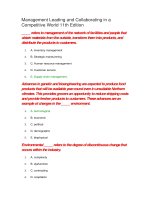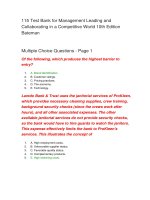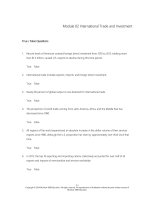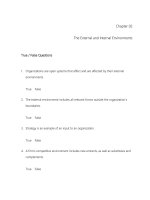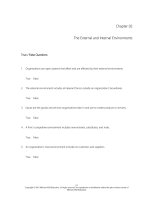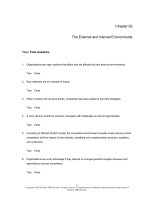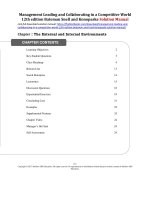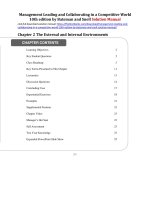96 management leading and collaborating in a competitive world 11th edition
Bạn đang xem bản rút gọn của tài liệu. Xem và tải ngay bản đầy đủ của tài liệu tại đây (131.27 KB, 25 trang )
Management Leading and Collaborating in a
Competitive World 11th Edition
_____ refers to management of the network of facilities and people that
obtain materials from the outside, transform them into products, and
distribute the products to customers.
1.
A. Inventory management
2.
B. Strategic maneuvering
3.
C. Human resource management
4.
D. Customer service
5.
E. Supply chain management.
Advances in genetic and bioengineering are expected to produce food
products that will be available year-round even in unsuitable Northern
climates. This provides grocers an opportunity to reduce shipping costs
and provide fresher products to customers. These advances are an
example of changes in the _____ environment.
1.
A. technological
2.
B. economic
3.
C. political
4.
D. demographic
5.
E. biophysical
Environmental _____ refers to the degree of discontinuous change that
occurs within the industry.
1.
A. complexity
2.
B. dysfunction
3.
C. contracting
4.
D. cooptation
5.
E. dynamism.
Which of the following is an element of Michael Porter's model for
analyzing the competitive environment of an organization?
1.
A. Substitutes
2.
B. Cost strategy
3.
C. Societal trends
4.
D. Regulatory forces
5.
E. Demographics.
Using bribery as a business tactic may result in fines for U.S. firms. Which
of the following types of environmental forces at work does this reflect?
1.
A. Competitive
2.
B. Economic
3.
C. Legal
4.
D. Technological
5.
E. Demographic
Laredo Bank & Trust uses the janitorial services of ProKleen, which
provides necessary cleaning supplies, personnel training, and
maintenance services. The other available janitorial services do not
provide maintenance services. In this case, if Laredo decides to terminate
ProKleen's services and shift to some other agency, it is likely to create
_____.
1.
A. high employment costs
2.
B. redemption costs
3.
C. favorable quality status
4.
D. complementary products
5.
E. high switching costs.
The method for predicting how variables will change in the future is
known as _____.
1.
A. budgeting
2.
B. buffering
3.
C. forecasting
4.
D. benchmarking
5.
E. scanning
Organizations are _____ systems, which means that they are affected by
and in turn affect their external environments.
1.
A. input
2.
B. output
3.
C. open
4.
D. closed
5.
E. social
If many factors prevent new companies from entering an industry, the:
1.
A. threat of new entrants is more serious.
2.
B. threat of competitive rivalry is high.
3.
C. threat to established firms is less serious.
4.
D. new companies can easily compete with the established ones.
5.
E. industry is said to have just a few barriers to entry.
Which of the following is an example of a potential substitute product?
1.
A. Hand sanitizer for soaps
2.
B. Ink cartridges for printers
3.
C. Mops for detergent
4.
D. iTunes for iPods
5.
E. Furniture for apartments.
The immediate environment surrounding a firm is known as its:
1.
A. macroenvironment.
2.
B. demographic environment.
3.
C. competitive environment.
4.
D. internal environment.
5.
E. economic environment.
A(n) _____ is a potential threat; customers use it as an alternative, buying
less of one kind of product but more of another.
1.
A. new entrant
2.
B. substitute
3.
C. ensemble
4.
D. divestiture
5.
E. complement.
_____ lead to new products, advanced production facilities, and better
ways of managing and communicating.
1.
A. Demographic shifts
2.
B. Societal preferences
3.
C. Political changes
4.
D. Technological advances
5.
E. Economic turbulences
Which of the following combinations can result in a best-case scenario?
1.
A. Many competitors, high threat with few entry barriers, and few customers
2.
B. Many competitors, high threat with few entry barriers, and many customers
3.
C. Few entry barriers, many substitutes, many customers
4.
D. High industry growth, low threat with many entry barriers, and customers with
low bargaining power
5.
E. Low industry growth, high threat with few entry barriers, and suppliers with low
bargaining power
Conditions that may prevent new firms from entering an industry are
referred to as _____.
1.
A. barriers to entry
2.
B. strategic maneuvers
3.
C. unfair trade practices
4.
D. industry regulators
5.
E. entry inhibitors.
_____ are specific government organizations in a firm's more immediate
task environment.
1.
A. Open systems
2.
B. Regulators
3.
C. Prospectors
4.
D. Stakeholders
5.
E. Defenders.
_____ trends regarding how people think and behave have major
implications for management of the labor force, corporate social actions,
and strategic decisions about products and markets.
1.
A. Psychological
2.
B. Political
3.
C. Economic
4.
D. Technological
5.
E. Societal.
Hospitals and universities are very expensive to run not only due to the
capital equipment that is required for each but also due to the personnel
such as specialized medical doctors and researchers. The cost of these
types of institutions is an example of _____.
1.
A. a barrier to entry
2.
B. environmental uncertainty
3.
C. unfair competition
4.
D. high switching costs
5.
E. strategic maneuvering.
_____ refers to a narrative that describes a particular set of future
conditions for a business.
1.
A. Benchmarking
2.
B. A scenario
3.
C. Strategic maneuvering
4.
D. A divestiture
5.
E. Strategic vision
_____ are fixed costs buyers face if they change suppliers.
1.
A. Changing costs
2.
B. Switching costs
3.
C. Renewable costs
4.
D. Exchange costs
5.
E. Sunk costs.
_____ are measures of various characteristics of the people who make up
groups or other social units.
1.
A. Psychographics
2.
B. Demographics
3.
C. Domain selections
4.
D. Lifestyle analytics
5.
E. Group dynamics.
Organizations must acquire a variety of resources in order to produce a
product or service of value. These resources may include materials,
equipment, financing, or even employees. The sources that provide these
various resources are referred to as _____.
1.
A. warehouse clubs
2.
B. regulators
3.
C. retailers
4.
D. suppliers
5.
E. prospectors.
A customer who purchases raw materials or wholesale products before
selling them to other parties is known as a(n) _____.
1.
A. final purchaser
2.
B. intermediate consumer
3.
C. final customer
4.
D. first-tier supplier
5.
E. preliminary customer.
Venus was a low-cost airline that was functional in the 1980s. Industry
analysts state that although Venus was able to provide all the services the
customers wanted, it was thrown out of business because of aggressive
pricing from larger airline firms. Which of the following aspects of the
competitive environment does this scenario illustrate?
1.
A. Customers
2.
B. Rivals
3.
C. Regulators
4.
D. The economy
5.
E. Social trends.
An outcome of environmental scanning is _____, the information
necessary to decide how best to manage in the competitive environment
managers have identified.
1.
A. corporate governance
2.
B. strategic vision
3.
C. competitive intelligence
4.
D. corporate espionage
5.
E. competitive dissertation.
Ranier Outdoor Clothing managers engage in an annual organizational
assessment, trying to predict industry changes as well as possible
opportunities and threats. They look at issues such as who their
competitors are, current entry barriers, and what substitutes exist for their
products. This assessment is called _____.
1.
A. scenario development
2.
B. forecasting
3.
C. benchmarking
4.
D. environmental scanning
5.
E. strategic maneuvering
A firm's current competition, suppliers, customers, and the threat of new
entrants or of substitutes are all elements in the _____.
1.
A. task environment
2.
B. Peter's model for organizational excellence
3.
C. microenvironment
4.
D. Porter's model for competitive environment
5.
E. supply chain management.
Liz, a new manager at a company, has been asked to focus on the
competitive environment of the organization. Which of the following is a
factor Liz should focus on?
1.
A. Government legislation
2.
B. Culture
3.
C. Demographics
4.
D. Buyers
5.
E. Technology
The main difference between a final consumer and an intermediate
consumer is that:
1.
A. the final consumer purchases finished products, whereas an intermediate
consumer only buys raw materials.
2.
B. intermediate consumers buy raw materials and sell finished products to final
consumers, whereas final consumers use the finished products.
3.
C. final consumers make more purchases than the intermediate consumers.
4.
D. unlike final consumers, intermediate consumers provide monetary benefits to
organizations by purchasing their products.
5.
E. final consumers tend to have more bargaining power than intermediate
consumers.
_____ create alternative combinations of different factors into a total
picture of the environment and a firm.
1.
A. Scenarios
2.
B. Forecasts
3.
C. Benchmarks
4.
D. Competitive intelligences
5.
E. Strategic maneuvers.
Giving consumers what they want or need, the way they want it, the first
time is known as _____.
1.
A. planned merchandise
2.
B. planned obsolescence
3.
C. customer service
4.
D. cause marketing
5.
E. operations management.
61 Free Test Bank for Management Leading and
Collaborating in a Competitive World 11th Edition
Bateman Multiple Choice Questions - Page 2
Two general types of proactive strategies for influencing an organization's
environment are _____
1.
A. dependent strategies and independent strategies.
2.
B. independent action and cooperative action.
3.
C. cooperative strategies and strategic maneuvering.
4.
D. strategic maneuvering and dependent strategies.
5.
E. independent action and strategic maneuvering.
The attitude and behavior patterns that shape people's experience of an
organization is called an organizational _____.
1.
A. culture
2.
B. climate
3.
C. environment
4.
D. strategy
5.
E. adhocracy
Quartermaine University has just formed a board of trustees and invited
25 of its wealthiest alumni to join. In this example, Quartermaine
University is demonstrating _____.
1.
A. contraction
2.
B. cooptation
3.
C. coalition
4.
D. political action
5.
E. voluntary action
Valley Organic Meats recently announced that it was selling off its pork
division in order to realign itself more competitively in the marketing of its
other products. Which of the following strategic maneuvers is illustrated
in this scenario?
1.
A. Diversification
2.
B. An acquisition
3.
C. A merger
4.
D. Divestiture
5.
E. Domain selection
Leveling normal fluctuations at the boundaries of the environment is
called _____.
1.
A. buffering
2.
B. smoothing
3.
C. flexible processing
4.
D. empowerment
5.
E. coalition
Purple Technology is a communication and information technology
corporation. The company makes it a point to stress to its employees that
innovation is its core strength. The employees even get an hour a day to
brainstorm and come up with out-of-the-box ideas. This highlights the
_____ of the company.
1.
A. cooperative strategies
2.
B. external environment
3.
C. organization culture
4.
D. competitive pacification
5.
E. domain selection
The process of sharing power with employees is called _____.
1.
A. empowerment
2.
B. downgrading
3.
C. benchmarking
4.
D. vertical synergy
5.
E. power building
According to the competing values model, if an organization's culture is
externally oriented and focused on control with its primary objectives as
productivity, planning, and efficiency, it could be best described as a(n)
_____ culture.
1.
A. group
2.
B. hierarchical
3.
C. rational
4.
D. adhocracy
5.
E. values-oriented.
Which of the following is true about using forecasts?
1.
A. Multiple forecasts are best, and their predictions can be averaged.
2.
B. Forecasts become more accurate while predicting further into the future.
3.
C. Forecasts are useless when the future will look radically different from the past.
4.
D. The more complex the forecast, the more accurate are the predictions.
5.
E. The accuracy of forecasts does not vary from one application to another.
Which of the following statements about organizational culture is true?
1.
A. Corporate mission statements are always a true expression of a firm's culture.
2.
B. Who is hired and fired and why indicate the firm's real value and are a clue to
the culture.
3.
C. A firm with a strong culture will have different people holding different values.
4.
5.
D. A culture that was advantageous in a prior era continues to be so in a new
environment.
E. It is unnecessary to consider culture when considering a merger.
When two or more companies work together to manage their external
environment, they are using _____.
1.
A. monopolistic strategies
2.
B. strategic maneuvering
3.
C. cooperative strategies
4.
D. dependent strategies
5.
E. competitive strategies.
When a brand advertises its products as being superior to that of its
competitors, it is demonstrating _____.
1.
A. competitive aggression
2.
B. competitive pacification
3.
C. benchmarking
4.
D. political action
5.
E. cooptation.
One firm buying another is called a(n) _____.
1.
A. merger
2.
B. acquisition
3.
C. divestiture
4.
D. prospective
5.
E. defender
Purple Lotus and GreenBolt are two leading e-commerce companies.
Recently, Purple Lotus engaged in an online price war with GreenBolt in
order to gain greater market share. This is an example of _____ on the part
of Purple Lotus.
1.
A. cooptation
2.
B. voluntary action
3.
C. competitive pacification
4.
D. competitive aggression
5.
E. environmental scanning
Alyssa owns Carver Gifts, a handmade greeting cards store. She is
projecting that the economy will rebound this fall. She ordered additional
holiday gift merchandise in February in anticipation of possible surge in
sales during the holiday season. In this case, which of the following
methods is Alyssa using to be sure she has enough gifts for those extra
holiday customers?
1.
A. Just-in-time inventory management
2.
B. Smoothing
3.
C. Benchmarking
4.
D. Buffering
5.
E. Diversification.
Dan's FroYo is a company that sells different varieties of frozen yogurt.
When Dan's FroYo spends its own money to promote the frozen yogurt
industry as a whole, the company is practicing _____.
1.
A. competitive aggression
2.
B. competitive pacification
3.
C. public relations
4.
D. voluntary cooptation
5.
E. comparative action
Candace recently got promoted to a managerial role in a bureaucratic
organization. The industry had been changing dramatically, and Candace
suggested that the management team encourage employees to develop
confidence by giving them some control and authority in order to create a
more flexible, adaptable organization. Here, Candace is suggesting the
use of _____ with employees.
1.
A. smoothing
2.
B. benchmarking
3.
C. empowerment
4.
D. cooptation
5.
E. coalition
_____ refers to the process of comparing an organization's practices and
technologies with those of other companies.
1.
A. Scenario planning
2.
B. Forecasting
3.
C. Benchmarking
4.
D. Environmental scanning
5.
E. Strategic maneuvering
Western Allied Heath and Grant Pharmaceuticals are two pharmaceutical
companies that have joined forces with one another to lobby against a
controversial Medicare reform. This action is referred to as _____.
1.
A. contraction
2.
B. coalition
3.
C. cooptation
4.
D. domain selection
5.
E. benchmarking
_____ strategies are used by an organization acting on its own to change
some aspect of its current environment.
1.
A. Flexible
2.
B. Buffering
3.
C. Independent
4.
D. Smoothing
5.
E. Cooperative
Which of the following can be a useful clue about an organization's
culture?
1.
A. The way employees interact with each other
2.
B. Information printed in the media about stock prices
3.
C. The macroenvironment
4.
D. The personality characteristics of employees
5.
E. The industrial environment
To improve customer service in its overseas call center, Jansen
Electronics decided to investigate the call center practices of competing
companies. The team discovered that a smaller company, Gorilla Devices
Inc., seemed to have outstanding customer service. The team then
determined differences between the organizations and developed a plan
to incorporate the best elements of Gorilla into Jansen. This illustrates
_____.
1.
A. environmental dynamism
2.
B. benchmarking
3.
C. strategic maneuvering
4.
D. cooperative action
5.
E. forecasting
The entrance by a company into another market or industry for which it
has an existing expertise is called _____.
1.
A. benchmarking
2.
B. strategic positioning
3.
C. outsourcing
4.
D. domain selection
5.
E. cooptation
Domain selection, diversification, mergers/acquisitions, and divestiture
are all examples of _____.
1.
A. illegal boundary management
2.
B. maneuvering the competition
3.
C. strategic maneuvering
4.
D. independent strategies
5.
E. portfolio maneuvering
Methods for adapting the technical core to changes in the environment
are known as _____.
1.
A. flexible processes
2.
B. smoothing effects
3.
C. buffering techniques
4.
D. benchmarking tools
5.
E. environmental scanners
_____ occurs when a firm invests in different types of businesses or
products or when it expands geographically to reduce its dependence on
a single market or technology.
1.
A. Domain selection
2.
B. Diversification
3.
C. Acquisition
4.
D. Divestiture
5.
E. Empowerment
NBIC (National Bicycle Industrial Company) of Japan specializes in mass
customization in order to cater to the changing demands of its customers.
Customers can choose the frame and other parts of the bicycle and it is
made according to their order. This is one example of how NBIC uses
_____.
1.
A. cooptation
2.
B. flexible processes
3.
C. smoothing techniques
4.
D. benchmarking
5.
E. diversification
Creating supplies of excess resources in case of unpredictable needs is
known as _____.
1.
A. cooptation
2.
B. smoothing
3.
C. flexible processing
4.
D. empowering
5.
E. buffering.
The set of important assumptions about an organization and its goals and
practices that members of the company share is called organization
_____.
1.
A. culture
2.
B. design
3.
C. climate
4.
D. layout
5.
E. structure
According to the competing values model, if an organization's culture is
internally oriented and flexible and tends to be based on the values and
norms associated with affiliation, it could be best described as a(n) _____.
1.
A. group culture
2.
B. hierarchical culture
3.
C. rational culture
4.
D. adhocracy
5.
E. closed system.
35 Free Test Bank for Management Leading and
Collaborating in a Competitive World 11th Edition
Bateman True - False Questions
Immigration is a factor that significantly influences the U.S. population
and labor force.
1.
True
2.
False
An organization's macroenvironment includes its customers and
suppliers.
1.
True
2.
False
In an organization, buffering refers to leveling normal fluctuations at the
boundaries of the environment.
1.
True
2.
False
Firms that develop strategies that do not include technological advances
run the risk of becoming obsolescent.
1.
True
2.
False
Cognitive intelligence is the information that helps managers determine
how to compete better.
1.
True
2.
False
Organizations are at a disadvantage if they become overly dependent on
any powerful supplier.
1.
True
2.
False
Family leave, flexible working hours, and child care assistance have been
introduced as a result of the evolving societal trends.
1.
True
2.
False
When investors bid up stock prices, companies have less capital to fuel
their strategies.
1.
True
2.
False
Michael Porter's model for competitive analysis is one example of
analyzing the competitive environment for adapting to and even
influencing the nature of competition.
1.
True
2.
False
Organizations that are defenders are more likely to engage in strategic
maneuvering than are prospectors.
1.
True
2.
False
Stories told by employees almost never have any connection to the true
culture of the organization.
1.
True
2.
False
A barrier to entry is a condition that prevents customers from using a
firm's products or services.
1.
True
2.
False
The goal of supply chain management is having the right product in the
right quantity at the right place at the right cost.
1.
True
2.
False
April, a manager in a call center, encourages her employees to solve
customers' problems without her approval of the particular situation. In
this case, April is trying to empower her employees.
1.
True
2.
False
A firm's competitive environment includes new entrants, substitutes, and
rivals.
1.
True
2.
False
U.S. government policies both impose strategic constraints and provide
opportunities for organizations.
1.
True
2.
False
Needing to learn a new software program as a result of changing
suppliers is an example of a switching cost.
1.
True
2.
False
In a dynamic environment, bureaucratic organizations are more efficient
than organic organizations.
1.
True
2.
False
According to Michael Porter's model, the competitive environment
includes rivalry among current competitors and the impact of new
entrants, substitute and complementary products, suppliers, and
customers.
1.
True
2.
False
Strategic maneuvering is the managing of the network of facilities and
people that obtain materials from outside the organization, transform
them into products, and distribute them to customers.
1.
True
2.
False
As a first step in understanding their competitive environment,
organizations must analyze how the competitors compete.
1.
True
2.
False
Population growth is unrelated to the size and composition of the labor
force.
1.
True
2.
False
Social metrics are measures of various characteristics of the people who
make up groups or other social units.
1.
True
2.
False
Regulatory agencies set rules but are typically weak institutions since
they do not have the power to investigate company practices or to take
legal action to ensure compliance with the law.
1.
True
2.
False
A more diverse workforce presents managers with challenges as well as
opportunities.
1.
True
2.
False
Environmental scanning means searching for and sorting through
information about the environment.
1.
True
2.
False
A strong organization culture is one in which everyone understands and
believes in the firm's goals, priorities, and practices.
1.
True
2.
False
While the stock market can impact a firm, it has no effect on the behavior
of individual managers.
1.
True
2.
False
The external environment includes all relevant forces outside an
organization's boundaries.
1.
True
2.
False
Cost is often a major barrier to entry into the marketplace.
1.
True
2.
False
Environmental uncertainty refers to the lack of information needed to
understand or predict the future.
1.
True
2.
False
Inputs are the goods and services organizations take in and use to create
products or services.
1.
True
2.
False
Benchmarking means identifying the best-in-class performance by a
company in a given area and then comparing one's processes to theirs.
1.
True
2.
False
Organizations are open systems that affect and are affected by their
external environments.
1.
True
2.
False
The Internet has empowered customers by providing an easy source of
information.
1.
True
2.
False

